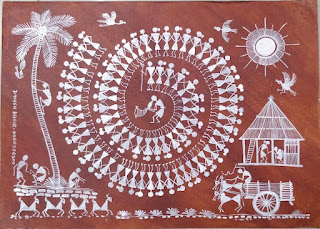 |
| Source: Media India Group |
One of those art forms is warli art. Warli art is admired for its simple yet elegant and monochromatic appearance. The extinction of such art forms has a major impact on those people who still earn their livelihood by practicing these art forms. There is a need to preserve these art forms as they form a major part of our rich culture and heritage, also because there are people who practice this art form as a means of survival.
History of Warli Art:
Warli art is a form of tribal art originated and practiced by people in the northern region the Sahyadri Range, which comprises cities like Jawhar, Palghar, Dahanu, Talasari, Mokhada, and Vikramgarh of Palghar district, in India. This warli tribal painting art form first originated in Maharashtra and is still practiced by the tribal communities.
It is believed that the warli painting started gaining recognition in the 1970s but it was originated around 10th century AD, however there is no evidence about the exact date of origin of warli art painting. This art was founded by Warli and Malkhar tribes that still resides in the northern regions of Maharashtra. People, especially women, still practices this art form by decorating the walls of their house with warli painting on special occasions.
Recipe Of The Paintings:
The white paste would be created by mixing rice, water and gum, and bamboo sticks, chewed at the end would be used as paintbrush. These elegant paintings use geometric shapes; circle, lines, dots, square, triangle and other geometric shapes, which symbolises different elements of mother earth where circle represents sun and moon, square represents temples, houses etc, and triangle, trees and mountains.
Style and Technique
These paintings seemed to be centred around various beautiful and abstract aspects of mother nature, the founders of the warli art were dependent on farming for their livelihood and thus there painting depicts various elements of nature as well as hunting, fishing, farming and other rural activities. In ancient times, these paintings were made with white colour paste on brown coloured walls, which was made of mud and cow dung.
The humans are drawn using two triangles connected with each other at the tips. The most important aspect of this art form is considered to be the ‘Tarpa Dance’. These painting seemed to be resembling cave paintings and tells us that how people used to live in ancient times and also about their culture and tradition.
According to Sanskriti Vintage,’warli art is performed during marriages and this was termed as ‘Lagnacha Chauk’. The meaning of this term is ‘marriage painting’ and this painting is done by only those women whose husbands are alive’.
In today’s world, people living in urban spaces use warli art to adorn the walls of their homes and also this art form is used by fashionistas to create and design sarees, kurtas, skirts, and other Indo western and ethnic attires. This art is slowly and gradually gaining recognition and admiration but it is less than what it actually deserves.
Written by: Harshita Bansal




.jpeg)





.jpeg)
0 Comments